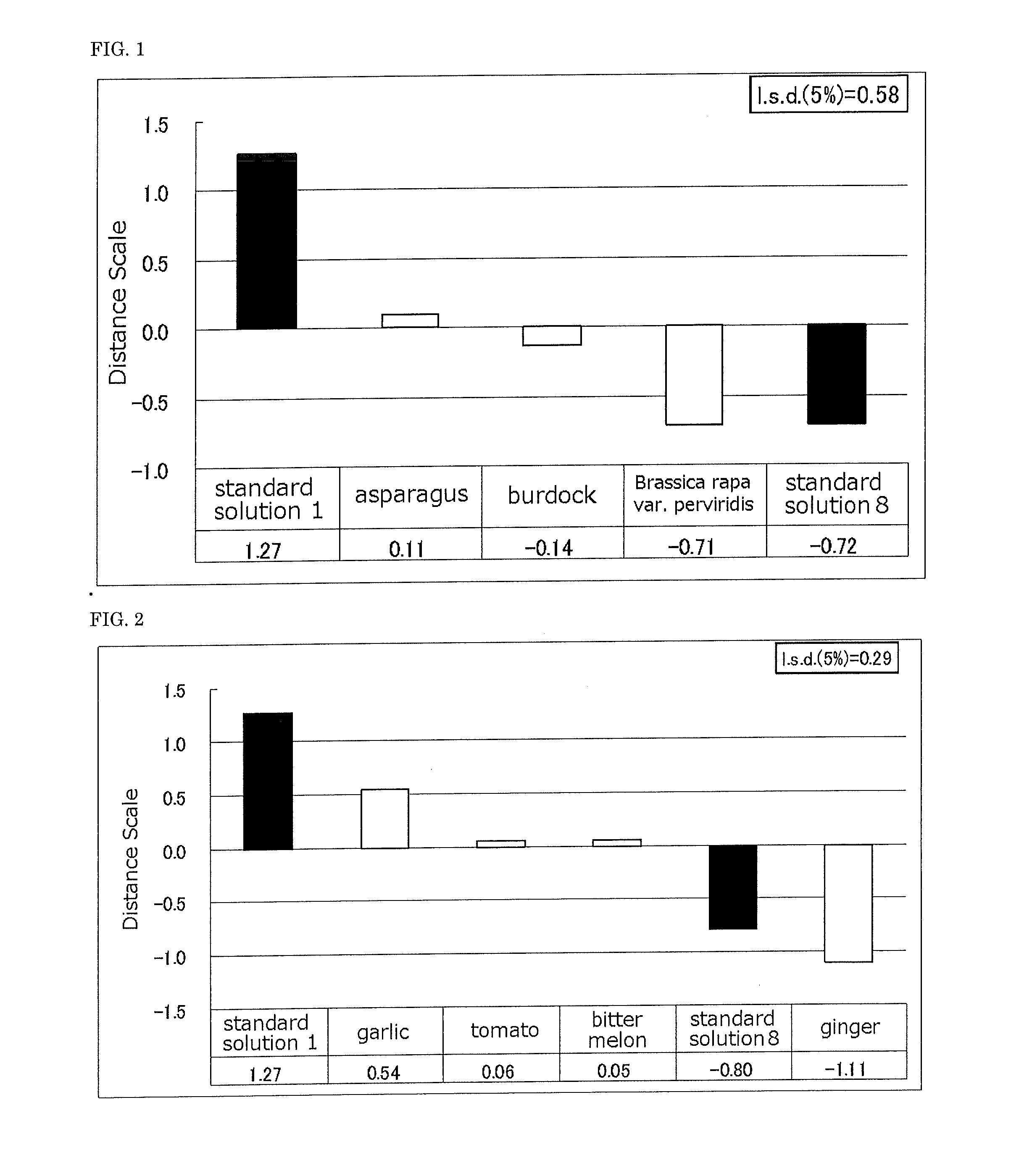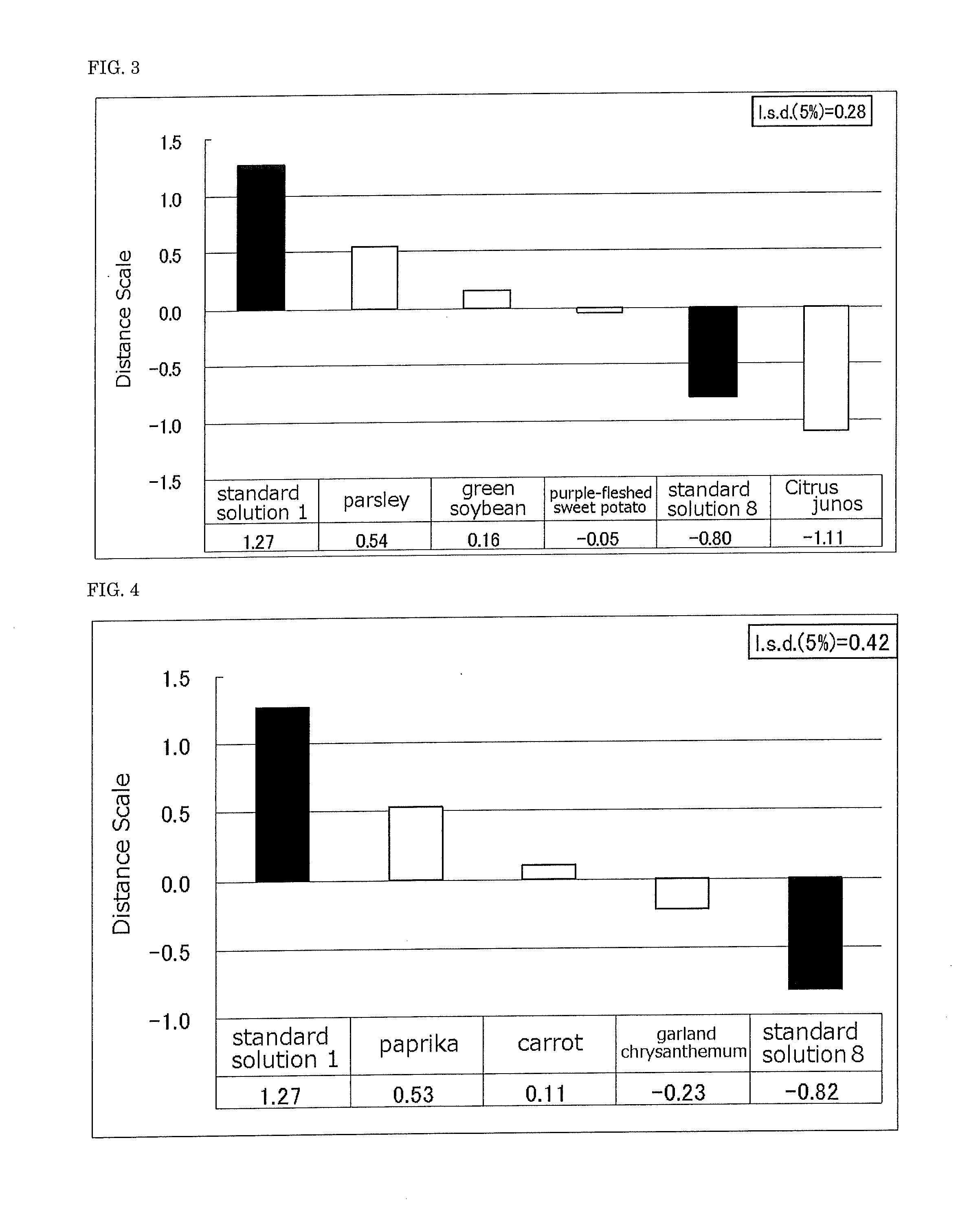Taste-improving agent and food or drink containing same
a technology of taste-enhancing agent and food or drink, applied in the field of taste-enhancing agent, can solve the problems of increasing the risk of occurrence of lifestyle-related diseases, high consumption of table salt, high blood pressure, etc., and achieves the effects of improving or reducing unpleasant bitterness, reducing the use of sodium salt, and good salty tas
- Summary
- Abstract
- Description
- Claims
- Application Information
AI Technical Summary
Benefits of technology
Problems solved by technology
Method used
Image
Examples
working example 1
Effect of Vegetable Extract for Improvement of Unpleasant Flavor of Potassium Chloride
(1) Production of Vegetable Extract
[0116]Distilled water was added to a respective 5 g sample of one of the 30 varieties of dried vegetable powder (i.e. paprika, garlic, onion (the above being produced by S & B Foods, Inc.); parsley, purple-fleshed sweet potato, Angelica keiskei, wormwood, mulberry leaves, barley grass, spinach, Corchorus olitorius, kale, green onion, cabbage, Brassica rapa var. perviridis, garland chrysanthemum, broccoli, celery, asparagus, ginger, Japanese radish, carrot, burdock, green soybean, tomato, Citrus junos, bitter melon, red bell pepper, yam, sweet potato (the above being produced by Kodama Foods Co., Ltd., each sample being the entire dried edible part of the vegetable)) to obtain a 200 g mixture, and then the mixture was heated in a water bath at 30° C. for 2 hours. Thereafter, the respective mixture was centrifuged (7,000 rpm for 15 minutes) and then was filtered thr...
working example 2
(1) Parsley Extract Concentration and the Effect of Improvement of Unpleasant Flavor of Potassium Chloride
[0119]The aforementioned parsley extract solution was added to obtain final concentrations of 0.025, 0.050, 0.075, 0.10, and 0.125 percent, and evaluations were performed by the evaluation method 1. The distance scale of each of the samples (i.e. result of evaluation) is plotted in FIG. 10.
[0120]As shown in FIG. 10, a potassium chloride unpleasant flavor improvement effect was found for each of the concentrations from 0.025 to 0.125 percent. At concentrations greater than or equal to 0.05 percent, a tendency was not seen for the potassium chloride unpleasant flavor improvement effect to increase in a concentration-dependent manner.
(2) Quantitative Measurement of Effect of Parsley Extract in Improvement of Unpleasant Flavor of Potassium Chloride
[0121]The aforementioned parsley extract solution was added to the standard solutions 4, 6, and 8 to obtain final concentrations of 0.05 ...
working example 3
Identification within Parsley Extract of Component for Improvement of Unpleasant Flavor of Potassium Chloride
[0123]The parsley extract obtained in Working Example 1 was fractionated sequentially by the below listed processing (1) to (4), and the component for improvement of the unpleasant flavor of potassium chloride was specified using the maintenance of a potassium chloride unpleasant flavor improvement effect as an indicator.
(1) Synthetic Adsorption Agent Column Processing
[0124]100 g of a 1 percent by weight aqueous solution of the parsley extract obtained in Working Example 1 was charged to a column (50 mL) loaded with synthetic adsorption agent (HP-20, produced by Mitsubishi Chemical Corp.), and the column was eluted in turn using 20 column volumes of distilled water, 15 volume percent ethanol in water solution, 50 volume percent ethanol in water solution, and ethanol. The obtained eluates were evaporated to form solids under vacuum to obtain the fractions 2 to 5. The obtained ...
PUM
 Login to View More
Login to View More Abstract
Description
Claims
Application Information
 Login to View More
Login to View More - R&D
- Intellectual Property
- Life Sciences
- Materials
- Tech Scout
- Unparalleled Data Quality
- Higher Quality Content
- 60% Fewer Hallucinations
Browse by: Latest US Patents, China's latest patents, Technical Efficacy Thesaurus, Application Domain, Technology Topic, Popular Technical Reports.
© 2025 PatSnap. All rights reserved.Legal|Privacy policy|Modern Slavery Act Transparency Statement|Sitemap|About US| Contact US: help@patsnap.com



